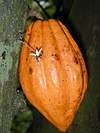Aerated chocolate
Aerated chocolate is a type of chocolate which has been turned into a foam via the addition of gas bubbles. The process for manufacturing it was invented by Rowntree's in 1947.[1][2] During manufacturing the fluid chocolate mass is foamed with a propellant, and then cooled in a low pressure environment. As the bubbles of gas expand they cool and help set the chocolate. This helps to maintain an even bubble distribution within the chocolate. Due to the isolating effect of the bubbles, air chocolate melts differently from compact bar chocolate — the mouthfeel is fragile-short at first, then as the chocolate is chewed it melts rapidly due to its bigger surface area. This intensifies the perception of taste.
_(cropped).jpg)
Nitrogen, argon, carbon dioxide and nitrous oxide are often used as propellants for air chocolate. Air itself is not used as a propellant because it contains oxygen which speeds up rancidification of the chocolate. A survey funded by Nestlé, conducted at the University of Reading, revealed that chocolate foamed with nitrogen — and especially with nitrous oxide — has the most intense taste. The researchers found that this was due to the larger bubbles which these gases produce.[3] Further research by Nestlé has concluded that "[t]he existing technology to control bubble size and distribution is difficult," which has led to experiments involving the creation of foams under zero-gravity conditions.[4]
In 2013, Chinese scientists announced results from a study using phospholipids derived from soybeans to aerate cocoa butter.[5][6]
Brands
- Aero (chocolate)
- Galaxy Bubbles
- Mirage (chocolate)
- Wispa
- Lotte Ghana
References
- GB 459582, Todd, John William & Rowntree & Co. Ltd, "Improvements in and relating to manufactured articles of food or confectionery", issued July 11, 1935
- GB 459583, Todd, John William & Rowntree & Co. Ltd, "Improved process for manufacturing articles of food or confectionery", issued July 11, 1935
- Haedelt, J.; Beckett, S. T.; Niranjan, K. (April 2007). "Bubble-included chocolate: relating structure with sensory response". Journal of Food Science. 72 (3): E138–142. doi:10.1111/j.1750-3841.2007.00313.x. PMID 17995803.
- Nieburg, Oliver (2012-07-06). "Nestlé in space: Aerated chocolate under zero-gravity". Confectionerynews.com. Retrieved 2013-05-21.
- Nieburg, Oliver (2013-03-12). "Aerated chocolate: new method for bubbles in cocoa butter". Confectionerynews.com. Retrieved 2013-05-21.
- Su-Jia, S.; Dong, C.; Shi-Chao, X (March 2013). "The Foaming Abilities of Surfactants in Cocoa Butter". The Journal of Food Process Engineering. 36 (4): 544–547. doi:10.1111/jfpe.12017.
